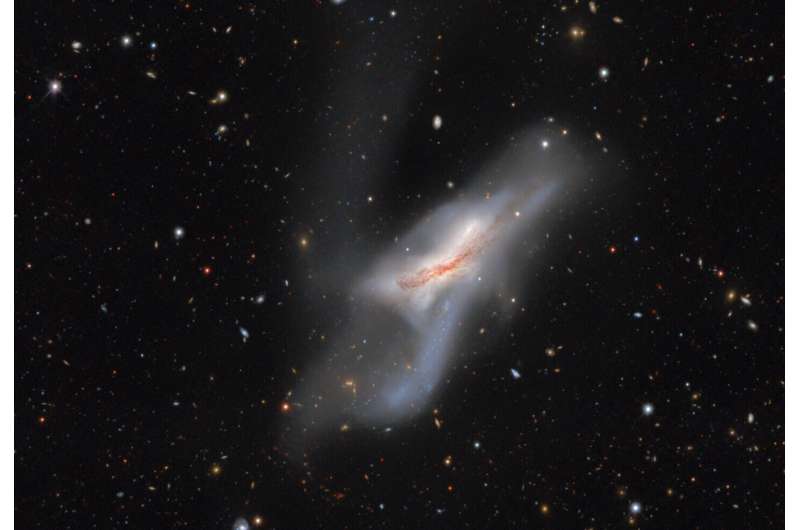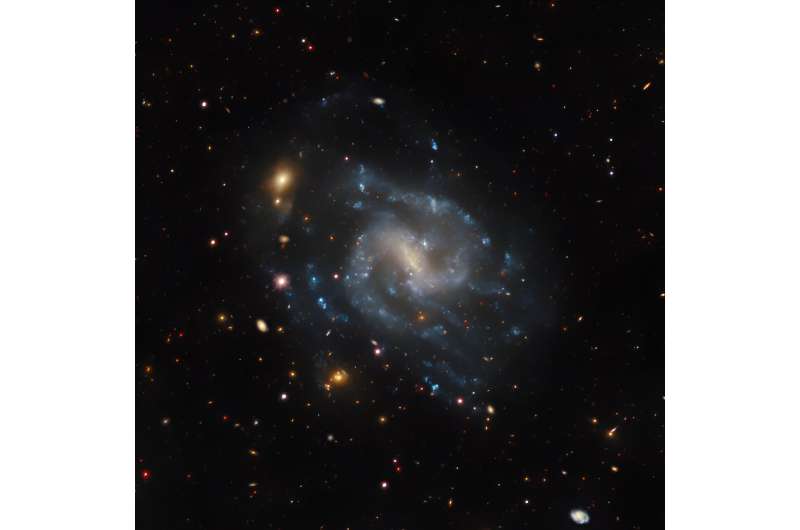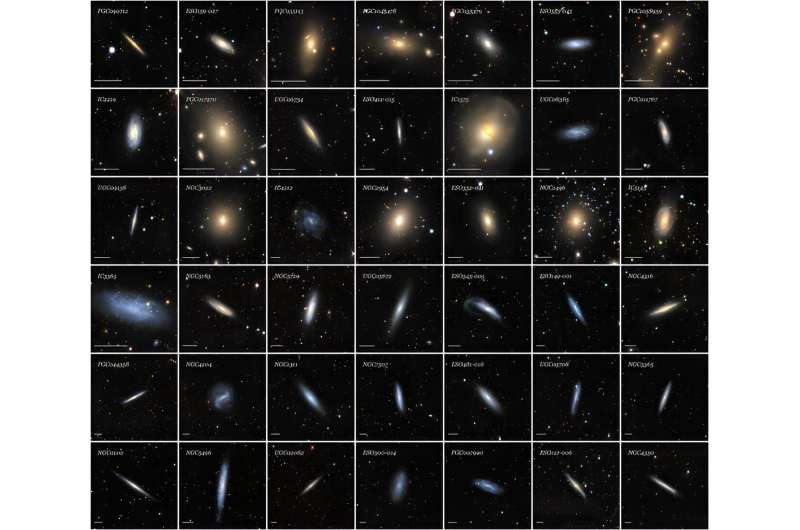This article has been reviewed according to Science X's editorial process and policies. Editors have highlighted the following attributes while ensuring the content's credibility:
fact-checked
trusted source
proofread
New map of space precisely measures nearly 400,000 nearby galaxies

Astronomers have created a detailed atlas of almost 400,000 galaxies in our cosmic neighborhood. The Siena Galaxy Atlas was compiled using data from NSF's NOIRLab telescopes, and is designed to be the preeminent digital galaxy atlas for large galaxies. It's a treasure trove of information for researchers investigating everything from galaxy formation and evolution to dark matter and gravitational waves. It's also freely available online for the public to explore.
This research was presented in a paper that appears in The Astrophysical Journal Supplement Series .
Astronomers have long sought to map the night skies, not only to fill in our picture of the cosmos we inhabit, but also to support further research. Comprehensive compilations of astronomical objects serve many purposes: they can help scientists spot broad patterns across a population of objects, put new discoveries such as transient events in the context of their surroundings, and identify the best candidates for focused observations.
However, these resources must be routinely updated to reflect the continuous technological improvements of telescopes. Now, a new atlas has been released with detailed information on over 380,000 galaxies at a greater level of accuracy than ever before, promising to be a boon to future astronomical inquiry.
The Siena Galaxy Atlas (SGA), is a compilation of data from three surveys completed between 2014 and 2017 known as the DESI Legacy Surveys, which were carried out to identify galaxy targets for the Dark Energy Spectroscopic Instrument (DESI) survey. Data were collected at Cerro Tololo Inter-American Observatory (CTIO) and Kitt Peak National Observatory (KPNO), both Programs of NSF's NOIRLab, and at the University of Arizona's Steward Observatory.
The DESI Legacy Surveys used state-of-the-art instruments on telescopes operated by NOIRLab: the Dark Energy Camera Legacy Survey (DECaLS), carried out using the DOE-built Dark Energy Camera (DECam) on the Víctor M. Blanco 4-meter Telescope at CTIO in Chile; the Mayall z-band Legacy Survey (MzLS) with the Mosaic3 camera on the Nicholas U. Mayall 4-meter Telescope at KPNO; and the Beijing-Arizona Sky Survey (BASS) with the 90Prime camera on the Bok 2.3-meter Telescope, which is operated by Steward Observatory and hosted at KPNO.
The DESI Legacy Imaging Surveys data, as well as a queryable copy of the full Siena Galaxy Atlas, are served to the astronomical community via the Astro Data Lab science platform and Astro Data Archive at NOIRLab's Community Science and Data Center (CSDC). The SGA contains additional data from a survey by NASA's Wide-field Infrared Survey Explorer (WISE) satellite that has been reprocessed by Aaron Meisner, an astronomer at NOIRLab.
These surveys captured images in optical and infrared wavelengths to chart a total area of 20,000 square degrees—nearly half of the night sky, making it among the largest galaxy surveys. Bringing this wealth of information together in one place, the SGA offers precise data on the locations, shapes and sizes of hundreds of thousands relatively nearby large galaxies. Besides the sheer number of objects recorded, the data in the SGA also achieve a new level of accuracy and it is the first such resource to provide data on the galaxies' light profiles.
"Nearby large galaxies are important because we can study them in more detail than any other galaxies in the universe; they are our cosmic neighbors," notes John Moustakas, professor of physics at Siena College and SGA project leader. "Not only are they strikingly beautiful, but they also hold the key to understanding how galaxies form and evolve, including our very own Milky Way galaxy."

The SGA builds on several centuries of efforts to chart the night skies. The iconic "Catalogue des Nébuleuses et des Amas d'Étoiles (Catalogue of Nebulae and Star Clusters)," published in 1774 by French astronomer Charles Messier, was a major milestone, as was the "New General Catalogue of Nebulae and Clusters of Stars (NGC)," published in 1888 by John Louis Emil Dreyer.
More recently, in 1991, astronomers assembled the "Third Reference Catalog of Bright Galaxies (RC3)." Several other valuable galaxy atlases have been published over the past two decades, but most of them draw on the photographic-plate measurements in the RC3, or are missing significant numbers of galaxies. Since the SGA uses digital images captured with highly sensitive instruments, it represents a substantial improvement in both data quality and completeness.
Arjun Dey, a NOIRLab astronomer who was involved in the project, explains, "Previous galaxy compilations have been plagued by incorrect positions, sizes and shapes of galaxies, and also contained entries which were not galaxies but stars or artifacts. The SGA cleans all this up for a large part of the sky. It also provides the best brightness measurements for galaxies, something we have not reliably had before for a sample of this size."
This versatile resource will drive progress in numerous branches of astronomy and astrophysics by helping scientists find the best galaxy samples for targeted observation. For example, the SGA will enhance research into how patterns of star formation vary across different galaxies, the physical processes underlying the diverse array of morphologies that galaxies display, and how the distribution of galaxies is related to how dark matter is spread across the universe. By acting as a map, the SGA will also help astronomers pinpoint the sources of transient signals like gravitational waves and understand the events that give rise to them.

"The SGA is going to be the pre-eminent digital galaxy atlas for large galaxies," says Dey.
However, he points out that the SGA is not just for academic researchers; it is freely available to view online for anyone wishing to get to know our corner of the universe better, adding, "In addition to its scientific utility, it has a lot of pictures of beautiful galaxies."
"The public release of these spectacular data contained in the atlas will have a real impact not only on astronomical research, but also on the public's ability to view and identify relatively nearby galaxies," says Chris Davis, NSF Program Director for NOIRLab. "Dedicated amateur astronomers will particularly love this as a go-to resource for learning more about some of the celestial targets they observe."
More information: John Moustakas et al, Siena Galaxy Atlas 2020, The Astrophysical Journal Supplement Series (2023). DOI: 10.3847/1538-4365/acfaa2
Provided by Lawrence Berkeley National Laboratory




















